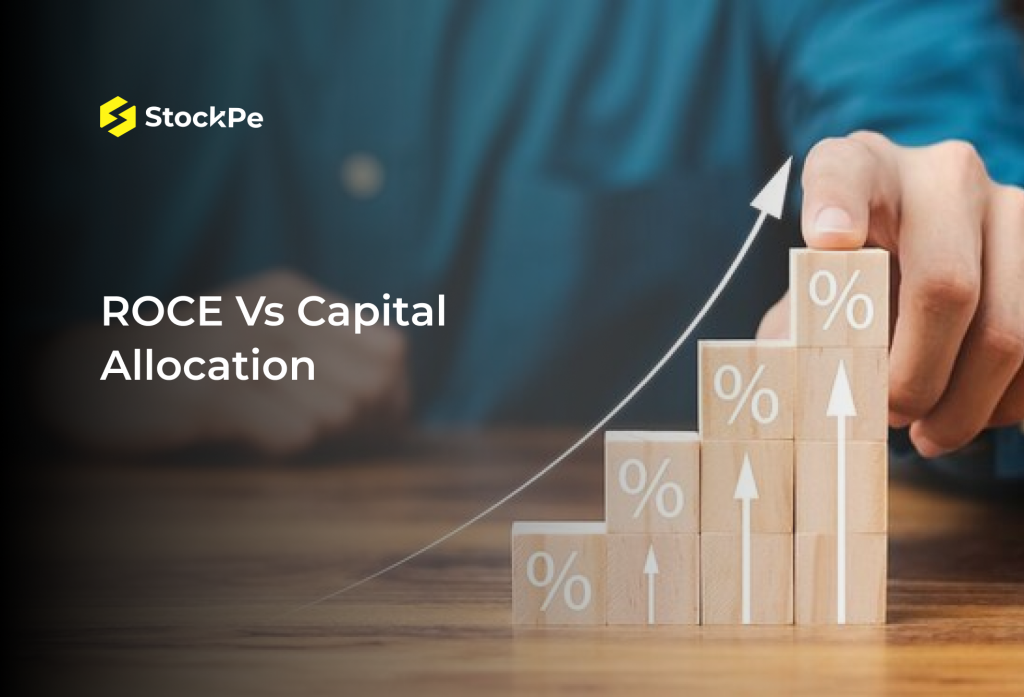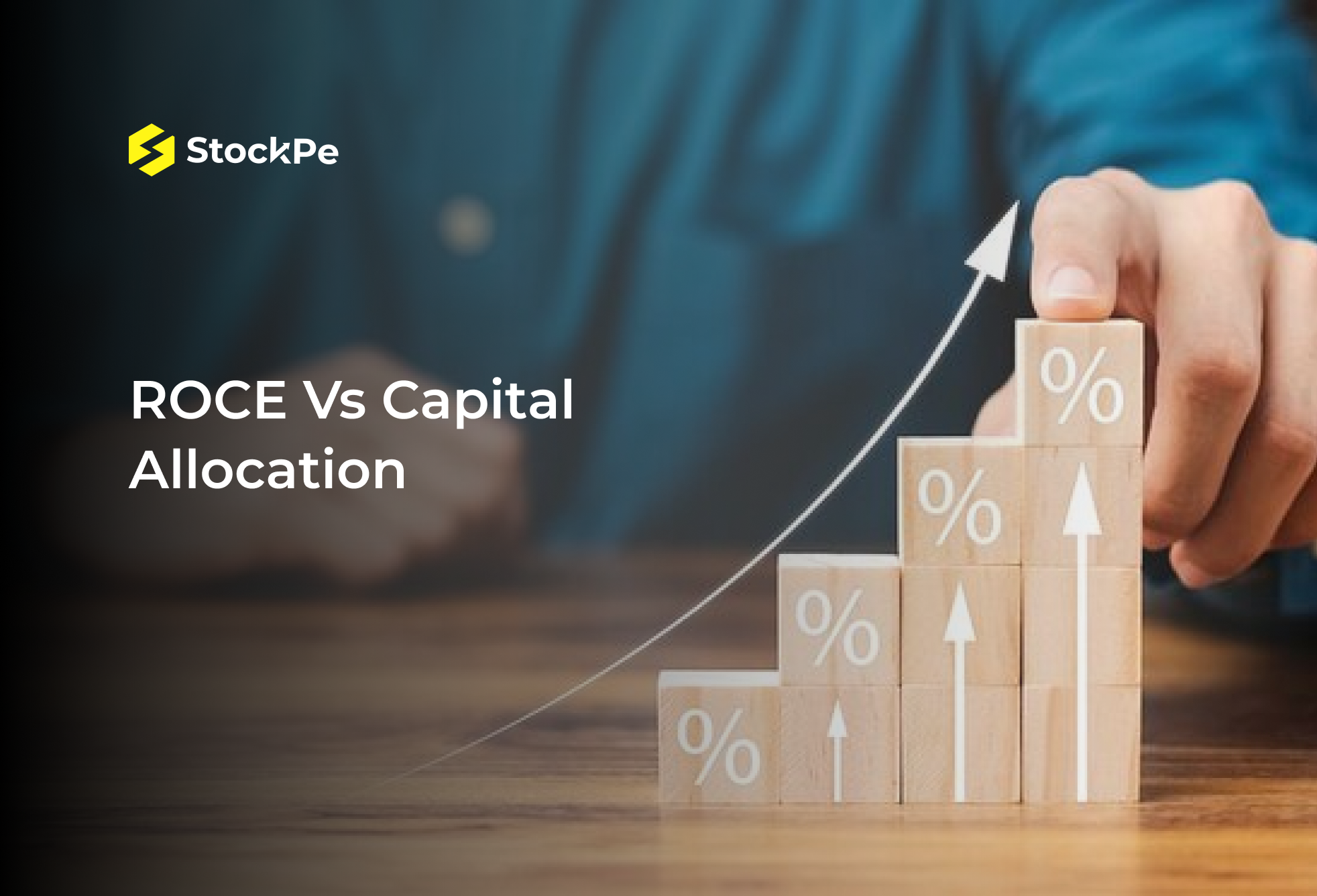Investors in today’s highly competitive markets must have a firm grasp of the elements that affect a company’s stock price. A few factors are more important to a company’s financial performance and stock price than its return on capital employed (ROCE) and capital allocation. This blog post will examine the fascinating relationship between the return on capital employed and strategic investment decisions, specifically how the latter might affect a company’s stock price.

How Is ROCE Employed?
ROCE is a financial ratio assessed annually and presented as a year-over-year trend line to track any discernible company performance shift. Return on Capital Employed (ROCE) is a crucial financial indicator since it measures a firm’s profitability relative to the amount of capital employed. The return on total capital employed (including stock and debt) measures a company’s profitability.
When evaluating the financial performance of businesses using comparable quantities of working capital, the return on capital employed ratio is a useful financial metric. Businesses operating in what are regarded as capital-intensive industries might also benefit greatly from this metric.
Return on capital employed (ROCE) is a profitability metric considering debt and other liabilities, unlike return on equity (ROE). The Return on Capital Employed (ROCE) ratio complements the Return on Equity (ROE) ratio, providing a complete picture of a company’s ability to profit from its available capital.
ROCE Formula and Calculation
ROCE= EBIT( earnings before interest and taxes)/Capital Employed (Total assets- Total Liabilities)
ROCE is calculated by dividing a company’s EBIT by the capital employed. Capital employed is the total of the balance sheet. It is generally accepted that a higher ROCE ratio indicates better capital allocation decisions.
Let’s look at the ROCE calculation to see how it works. Let’s pretend that ABC Ltd. has an EBIT of Rs 300 Crore throughout one fiscal year. However, in the same fiscal year, EBIT for Company XYZ Ltd is Rs 250 crore.
Compared to Company XYZ Ltd., ABC Ltd. appears to be a better investment due to its greater EBIT. However, Return on Capital Employed (ROCE) is the ideal metric for deciding between companies. Let’s say Company ABC Ltd. has invested Rs 900 Crore and Company XYZ Ltd. has invested Rs 700 Crore.
ROCE (Company ABC Ltd) = 300 / 900 = 0.333.
ROCE (Company XYZ Ltd) = 250 / 700 = 0.357.
Because of its higher ROCE, although having a smaller EBIT, Company XYZ Ltd. is a superior investment to Company ABC Ltd. The ABC and XYZ company generated 0.33 and 0.357 as increased returns on invested capital.
If a corporation has a high ROCE, it makes good use of its money in the long term. This demonstrates the company’s profitability and should encourage more investors to back it. Stock price increases are possible for companies with consistently high ROCE because of the positive perception they inspire in investors’ minds.
Allocating Capital for Strategic Expansion
Strategically investing in growth possibilities, making acquisitions, paying down debt, paying dividends, and repurchasing shares are all examples of capital allocation. A company’s stock price and financial results are affected by how its money is allocated.
● Growth Investments: Businesses that put money into initiatives with significant room for expansion typically attract the attention of long-term financiers. Expenditures in this category may go toward things like R&D, the introduction of a new product, market expansion, or technological development. Stock prices can rise if growth investments increase earnings, sales, and market share.
● Acquisition: The success of an acquisition is a key factor in determining the stock price. When an acquired business is a good fit for the acquirer’s current operations and leads to synergies, it benefits investors and raises the stock price. However, shareholder value can be eroded, and stock prices might fall due to poorly performed or expensive acquisitions.
● Buy Back Shares Or Distribute Dividends: Companies that routinely buy back shares or distribute dividends to their owners are seen favorably by investors. Dividends provide a stable source of income, and share repurchases can lower the number of shares outstanding and boost earnings per share. These things boost investor confidence, which in turn can raise stock values.
A Glimpse of High and Low ROCE
The interplay between the ROCE and the distribution of that labor is complex. A high ROCE indicates a corporation has sufficient cash flow to make important capital allocation choices. In contrast, a business with a low ROCE may need help to generate adequate returns on investments, restricting its capacity for efficient resource allocation.
● High ROCE: Consistently high returns on capital employed (ROCE) indicate effective capital usage and the ability to self-finance expansion efforts. This puts the company in a good position to grow or make acquisitions to increase shareholder value. Therefore, the stock price of such a company may rise as investors see it as a good investment opportunity.
● Low ROCE: A low ROCE may make it difficult for a company to attract investors since it may need help earning enough money for expansion or dividends. In such a situation, businesses need to reassess their approaches to allocating resources to boost operational efficiency and find new growth opportunities. The company’s stock price may rise if investor trust is restored, which can be accomplished by increasing the return on capital employed (ROCE).
Boosting Return on Capital Employed
Since ROCE is a profitability ratio, it may be increased in the same ways that a company’s total profitability increases. Cutting expenses or boosting revenue is a natural first step. Operating efficiency relies largely on identifying and investigating wasteful or unnecessary spending sources.
● Reducing liabilities by paying off debt is another way to boost ROCE. The corporation can also improve its financial standing by refinancing its debt at more favorable interest rates and payback conditions.
● Improving inventory management is a crucial area that could lead to greater operational efficiency. When done correctly, inventory management can be a powerful tool for boosting a company’s bottom line.
● A company’s cash flow and available working capital can be greatly improved via careful monitoring, organization, and coordination of ordering goods. This permits the business to reinvest its earnings regularly, expanding its operations and customer base.
Summing Up
As a result, both returns on capital employed and capital allocation play significant roles in determining a stock’s value. Increased investor confidence is associated with a high ROCE. Stock prices can be boosted by attracting investors with smart capital allocation decisions like making strategic investments and paying dividends.
Maximizing shareholder value and ensuring long-term success in the volatile stock market requires companies to maximize their ROCE and ensure prudent capital allocation.





